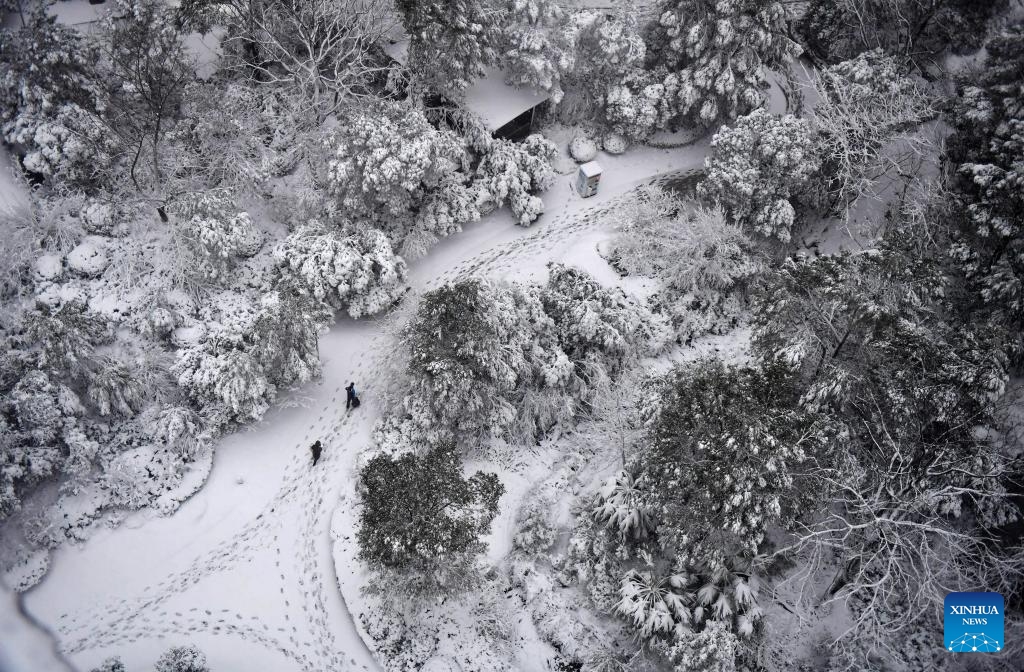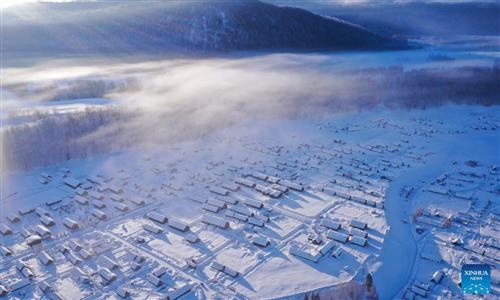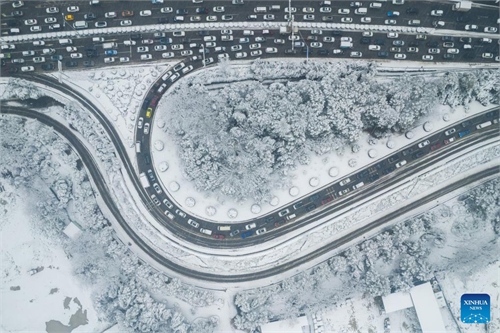Localities make emergency plans in response to unprecedented weather challenges during ‘busiest’ Spring Festival travel rush

People walk in the snow in Changsha, central China's Hunan Province, Jan. 22, 2024. Changsha saw its first snowfall of 2024 from Sunday night to Monday morning(Photo: Xinhua)
From Wednesday on, China's central and eastern regions will experience the largest range and longest period of rain and snow, which will be the most complex weather during the Spring Festival travel rush since 2008.
Given that 9 billion trips are expected to be made during the "busiest" Spring Festival travel rush (January 26-March 5) this year, setting a record high, as well as the areas seriously affected by rain and snow being located in the central transportation hubs, which is very unfavorable to high-traffic trave, many localities are deploying resources and making emergency plans to ease the impact of the extreme weather.
According to the Central Meteorological Administration (CMA), from January 31 to February 5, the central and eastern regions of China will have a large range of continuous rain and snow, 10 provinces will have heavy snow, Central China's Henan and Hubei provinces, East China's Shandong Province and other regions will have extreme accumulative snowfall. Five provinces - Henan, Hubei, East China's Anhui, Central China's Hunan and Southwest China's Guizhou -- will have freezing rain.
The range of rain and snow is large, covering the entire central and eastern regions of the country, of which Henan and Hubei and Shandong provinces are estimated to accumulate snowfall close to or exceed the historical period.
The rain and snow is expected to last from January 31 to February 5 in the central and eastern regions.
The weather complexity may lie in the adjustment of the heavy snowfall area. There is still a possibility of an adjustment of the heavy snowfall area after the Jianghuai cyclone (a typical cyclone appearing in the areas between the Yangtze River and the Huaihe River) moved north, especially after February 2. However, on the whole, Henan and Shandong provinces will likely be the center of heavy snowfall. If the Jicyclone moves all the way north, then Northeast China also needs to pay attention to the strong snow weather.
The CMA noted that the weather complexity is also reflected in the wide range of freezing rain. This winter, more provinces will suffer from the freezing rain than any other winter. From February 1 to 4, southern Henan, Hubei, northern Anhui, central and northern Hunan, eastern Guizhou and other provinces and regions will have freezing rain.
Meteorologists noted that the problem is not that there has not been heavier rain and snow in the past. The main problem is that this time it will affect the Spring Festival travel rush. According to data, there is expected to be 9 billion trips during the annual biggest travel rush this year, and the total number of commercial passenger transport such as railways, roads, waterways and civil aviation will welcome over 1.8 billion trips, an increase of about 40 percent, a record high.
Ma Jun, director of the Beijing-based Institute of Public and Environmental Affairs, told the Global Times on Wednesday that the freezing rain has been particularly damaging to transport and power supplies, urging the relevant departments to prepare well and actively deal with the potential impact.
The freezing rain particularly has a huge impact on the road traffic and it is estimated that road disruption and congestion will occur during the Spring Festival travel rush, according to Ma. He noted that electric vehicles could be affected more by the extreme weather, calling on the relevant departments to ensure working power supply.
Shandong, Henan, North China's Shanxi, Hebei provinces have issued warnings for heavy snowfall and low temperatures.
On Tuesday, the Shandong Meteorological Bureau issued a yellow alert for ice on roads, a yellow alert for strong winds at sea and a blue alert for strong winds inland.
The Meteorological Disaster Prevention Headquarters Office of Hebei Province issued a notice on the same day, requiring all departments to do a good job to ensure the safety of transportation during the Spring Festival, and resolutely safeguard people's lives, property and social stability.
According to local media outlets, relevant departments at all levels in Hebei are requested to implement an early warning mechanism, and make every effort to do a good job of meteorological support services and energy supply guarantee during the Spring Festival travel rush.
Also on Tuesday, Shanxi required all efforts to do a good job of research and judgment, monitoring and early warning, command and dispatch, rescue, disaster relief and other work, to ensure the safety of people's lives and property.
Meteorologists from CMA said the last time there was an impressive large-scale rain and snow freezing weather during the Spring Festival travel rush was in 2016, and before then in early 2008 in southern China. Fortunately, according to the current forecast, this year will not encounter extreme situation as in 2008.
CMA said that the duration of rain and snow, low temperature intensity, freezing range this time are less than in the winter of 2008.
CMA also had good news, saying that after seven days, the weather in the middle and lower reaches of the Yangtze River along the north will clear up, and the weather is expected to be much calmer on the way home toward the end of the Spring Festival.



